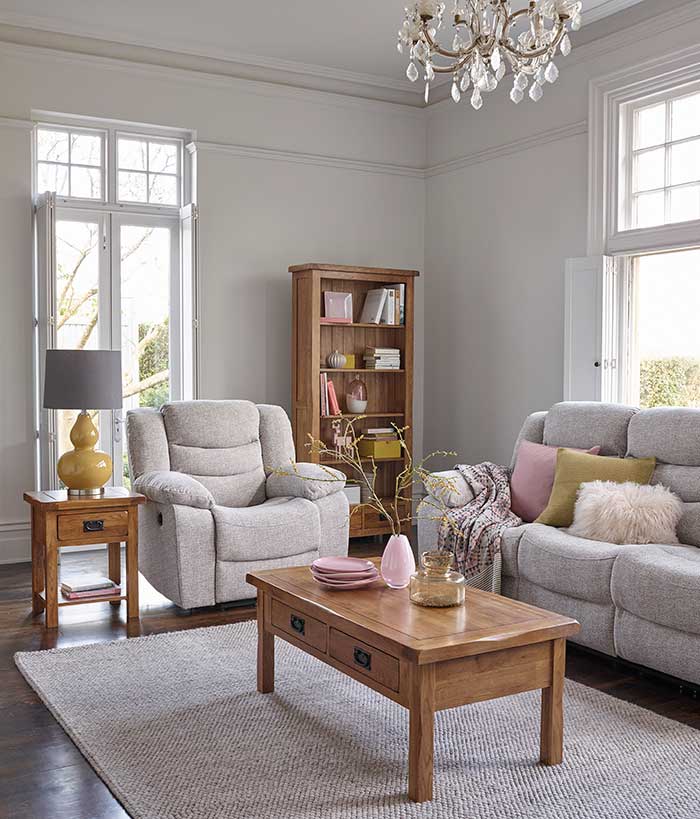It’s easy to get caught up in the rabbit holes that are Pinterest, Instagram and interior design websites for inspiration, but you’d be forgiven for thinking that huge rooms with great light, high ceilings and multiple seating areas are the norm. The reality, for most of us, is that we’re living with smaller spaces that need to work extra hard – both for ourselves and for our families and guests. If your living room is more on the bijou side, however, there’s no reason why it can’t be an amazing space that fulfils whatever you require of it – from family TV nights to entertaining friends to carving out a place to work and play.
Discover how to maximise your small living room, with the top tips you need to make the most of the space you have.
Scale your larger furnishings
Make a note of how the flow of the room works – where things like windows and doors are as well as where electrical points are and make sure you have your room measurements handy when shopping. After all, there’s no point in dreaming about a big L-shaped sofa if it’s blocking the door to the hallway or you can’t walk across the room to grab a cuppa from the kitchen. When choosing furniture, consider using masking tape on the floor to mirror the size of the pieces in the room. This will help you envision how much space things like sofas, tables, storage and armchairs will take up.
You may find a 2-seater sofa with an armchair may fit the room much better than a large 3-seater sofa. You also may want to look for sofas with slimmer arms which will take up less room than something with a larger, deeper frame.
Ensuring your furniture is to scale will ensure you make the most of your space for the largest pieces. If you want to play with scale a bit, pair smaller sized furniture with an oversized light fixture or larger art pieces for the wall which will fool your eye into thinking the space is bigger than it is.
Choose double-duty furniture
When choosing furniture, look out for pieces that do double duty. A coffee table with drawers will provide some storage for things like remote controls, books or board games. An ottoman that opens will allow for additional throws or cushions to be pulled out when comfort calls without using more space than a normal footstool. Consider baskets for bookshelves where children’s toys can be stored out of site. Nests of tables can come in handy as well – the smallest tables can be used as additional seating or surfaces when the need arises but easily stowed away when not in use.
Pull furniture away from walls
If it’s possible, resist the urge to put all your furniture against the walls. Consider floating some furniture in the middle of the room to create a more interesting flow and to give the illusion of more space. An armchair or loveseat can be moved to create a more intimate conversation area or a sofa can have a larger console behind it as a place to put table lamps, books and accessories.
Looking for more tips to using nesting tables? Check out our post here.
Make use of vertical space
When your floorspace is limited, consider going up instead. Floating shelves can create additional storage without taking up precious real estate in a room. Make the most of awkward spaces like alcoves with built in storage and shelves or tall slim bookshelves which will make better use of the vertical space in the room and provide plenty of space to house books, pictures and accessories.
Consider mirrors
While mirrors won’t necessarily provide any additional storage or create space where there is none, it will give you the illusion of a bigger space. Placed across from a window, it’ll bounce light back into the room and will create depth, making it look as though your room has doubled in size.
Choose colour and pattern wisely
And finally, remember that your colour palette will influence the feel of a smaller living room. Bold colourful wallpaper will naturally make a room look smaller if the pattern dominates the space while darker colours will create an enveloping cosy feeling.
If you want your room to feel bigger, consider paler colours or work within a tighter colour palette (no more than 2-3 different colours) to give the illusion of a bright, light and airy space even if it’s on the smaller side.
Don’t forget to show us how you’ve made the most of your living room using #OakFurnitureland on Instagram.

